The Jubilee Battery was another part of Hong Kong's defences in the Second World War. It is located on the Western end of Hong Kong Island at the foot of Mount Davis, below Victoria Road. (Victoria Road was previously named "Jubilee Road").
It is easy to see where the road towards the battery starts, as there is a gap in the pavement where the road branches off. There is a fence across the entrance, but there is an unlocked gate that lets you in. The road is clear to start with, and easy to follow.
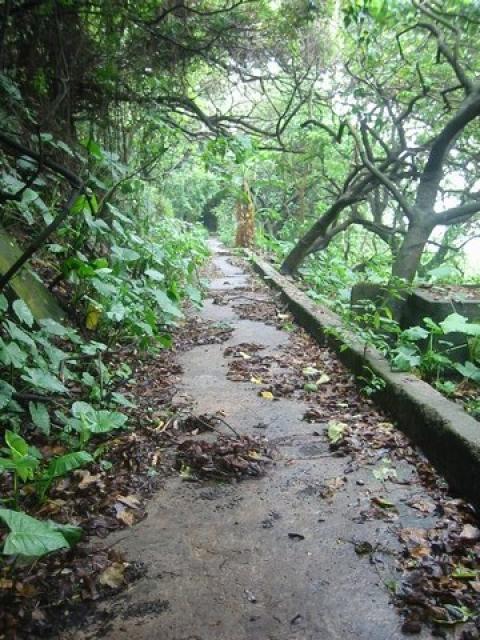
There are signs that there were buildings along the sea-side of the road, but nothing very clear until you come to a junction. The road branches off to the right, a path continues straight ahead, and there is this tunnel entrance on the left.
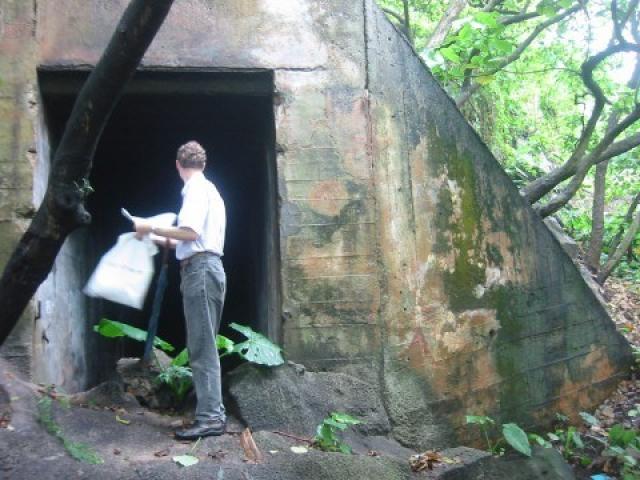
You'll need to bring torches if you want to look inside. There are rooms off to the left of the tunnel, then at the end the tunnel opens into a large room.
The flash on my little digital camera had a hard time filling the room:
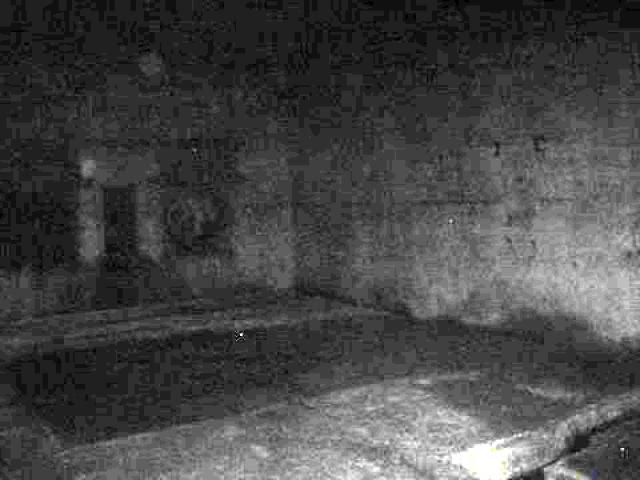
Read the background to these photos here.
At the end of the room you can make out two openings, and the one on the right has a round shape.
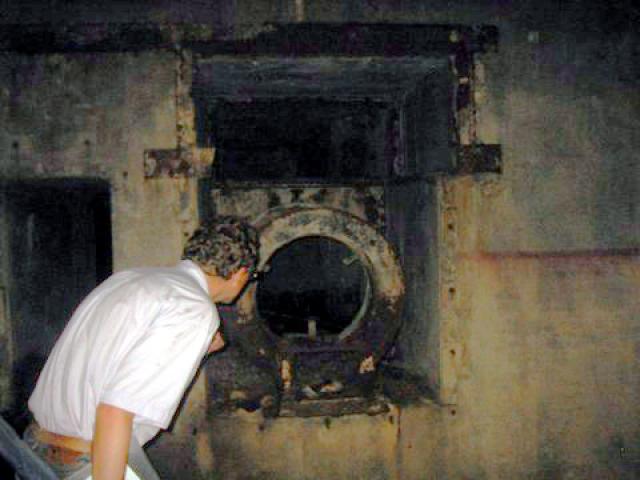
Read the background to these photos here.
Here it is in more detail :

Read the background to these photos here.
You can see signs of a smaller tunnel in the background. Maybe this was for ventilation?
The opening on the left is in worse condition, but it is easier to see the tunnel in the background :
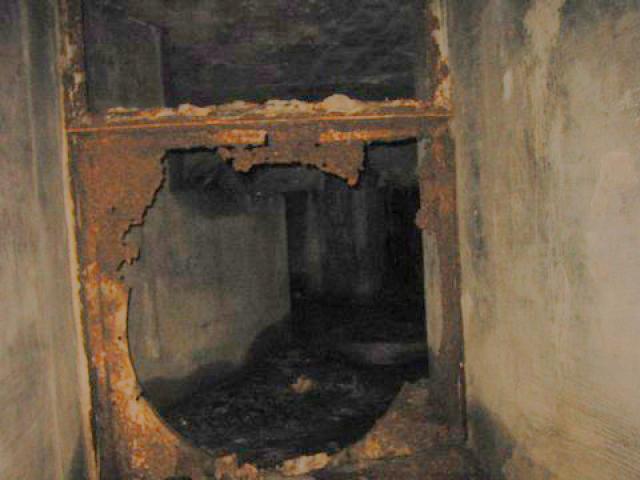
Read the background to these photos here.
Back outside again, and we took the right fork to follow the main road.
A short way ahead and the road becomes very overgrown, but there is a path to the left that should lead to the first gun emplacement. After pushing through the first bushes, the undergrowth thins out and the ground is very flat, so we felt we were heading in the right direction :
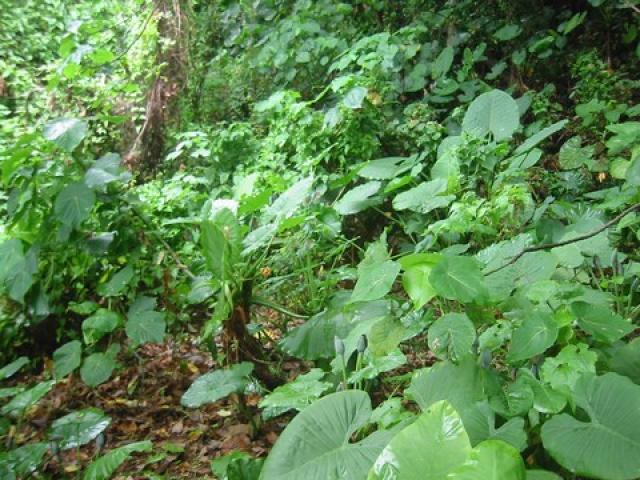
Read the background to these photos here.
Then shortly afterwards we saw the curved wall that was the back of the emplacement, with a narrow doorway :
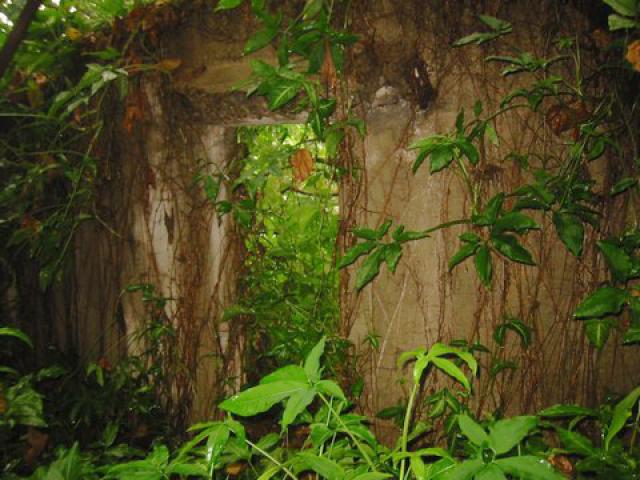
Read the background to these photos here.
To the left and slightly behind the emplacement, is a low building :

Read the background to these photos here.
We went through the doorway in the back of the emplacement wall -- here's the view of the same wall from the inside. The curve of the round emplacement is clear to see, but the emplacement is very overgrown:
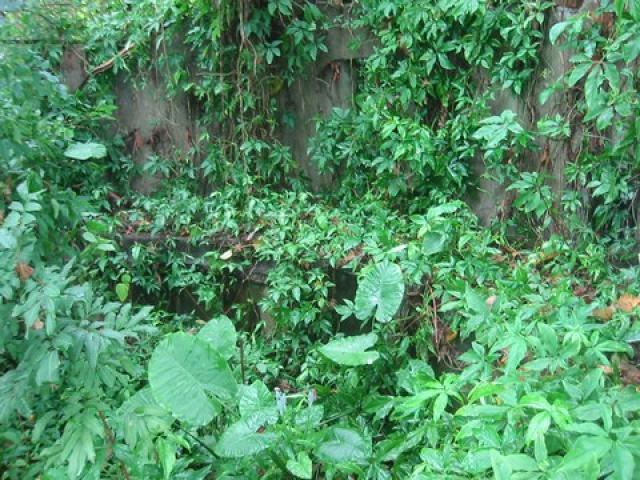
Read the background to these photos here.
Throughout the walk you can hear the sea, and the map shows that the battery is mostly just 20-30 metres above sea level. Where there are gaps in the tree cover, you can see that the battery had a clear view of the Western approaches to Hong Kong Harbour, and around as far as Lamma Island (you can just see the Lamma power-station chimneys in this photo) :

Read the background to these photos here.
Although it is not shown on the map, from the front-left corner of the emplacement is a staircase leading you down to rejoin the road. There is not much sign of steps in this photo, but it is quite easy to walk down :
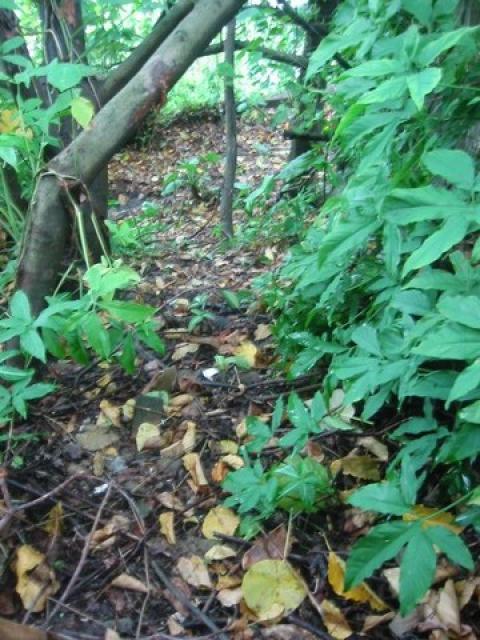
Read the background to these photos here.
From the road at the bottom of the steps, the emplacement is hidden from view by this small cliff :
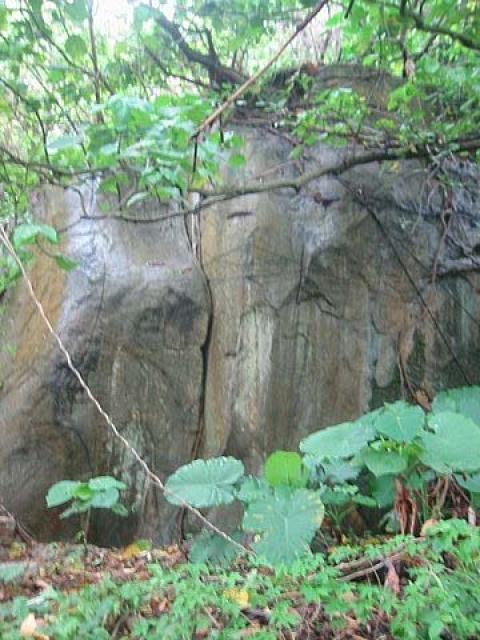
Read the background to these photos here.
The good news is that we have bypassed the overgrown section of the road, which is now clear again :
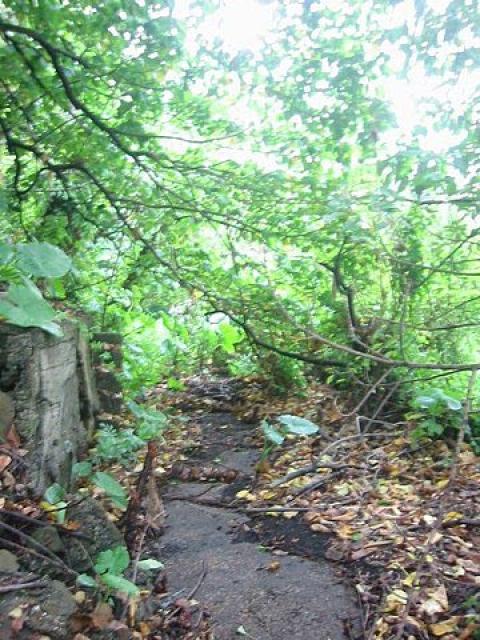
Read the background to these photos here.
Heading onwards, we come to another, smaller tunnel opening. This tunnel is very wet, so we'll leave it for another day :
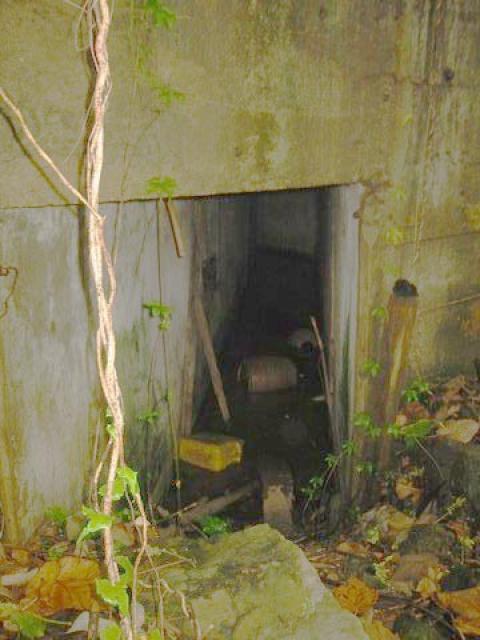
Read the background to these photos here.
We carried on a little way, then scrambled up a steep slope to reach the third emplacement. Its layout is almost identical to the first emplacement. Here we are inside the emplacement, looking at the curved wall at the back of the emplacement and the doorway cut into it:
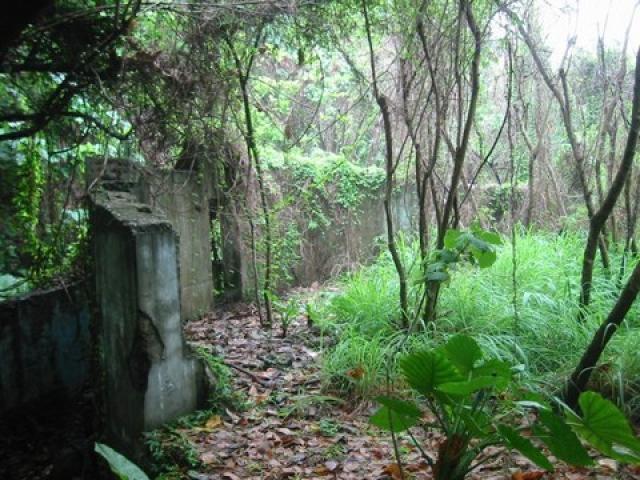
Read the background to these photos here.
This emplacement is much less overgrown. Here's the view along the back wall, with the ceramic wall tiles showing that the buildings were lived in by squatters at some time over the last 60 years :
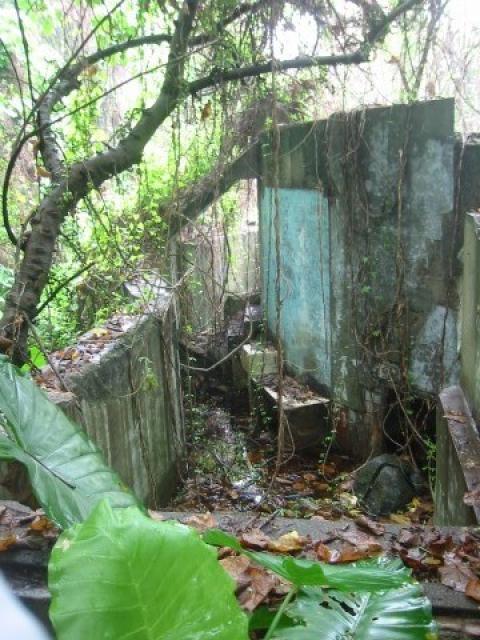
Read the background to these photos here.
Following the same layout as emplacement number one, at the back of the emplacement is a small, solid building. Someone has cleared away the undergrowth recently, making this one much easier to see :

Read the background to these photos here.
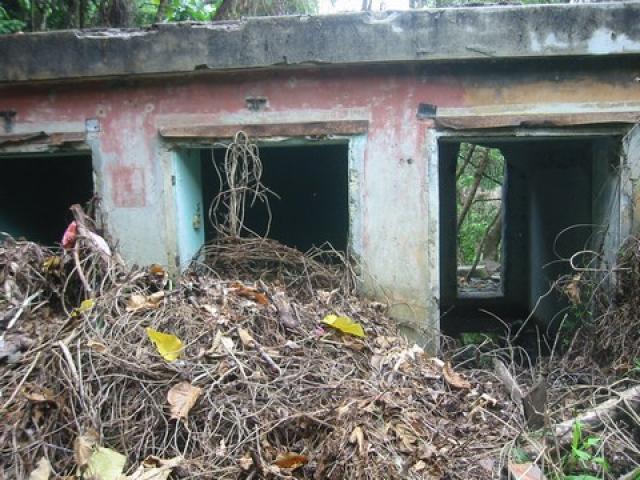
Read the background to these photos here.
Walking through the building, it was clear we'd chosen the difficult end to begin - here is a smart new staircase, courtesy of the Hong Kong Government ! It joins Victoria road just opposite to the 5A bus terminus. Starting from this end, you should at least be able to see emplacement number 3 without much difficulty.
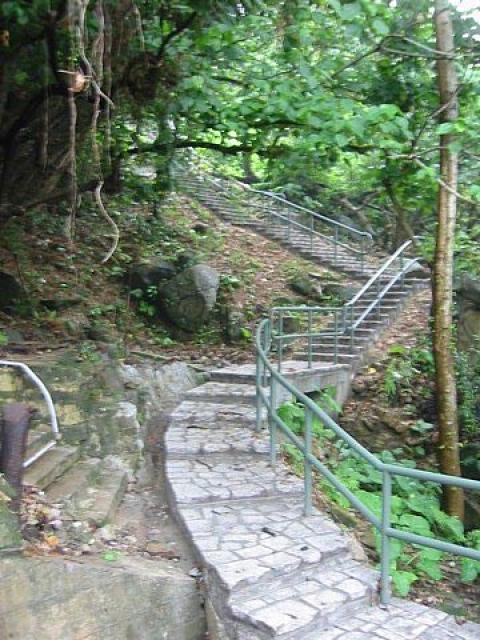
Read the background to these photos here.
Looking back you get another view of that same low building :

Read the background to these photos here.
Then looking up the hill you see where there should be a path to the second emplacement, but unfortunately that lies within a fenced-off area. Does anyone know what that fenced-off area is ?
The buildings inside are visible from Victoria Road, and there is a sign on the roof that says "Oriental Hotel". But it's always looked an unlikely building to be a hotel, as it has sturdy barbed-wire fencing all around it. Curious. Anyway, this is all you get to see as you look up towards the second emplacement :

Read the background to these photos here.
To finish off the walk, follow the steps down to find a pleasant sitting area right by the sea :
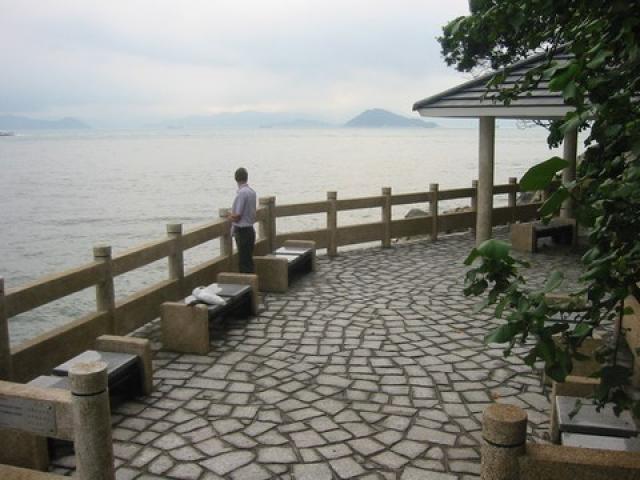
Read the background to these photos here.
Other things to think about - We went in May after a heavy rain, and met a warm welcome from the local Mosquitoes :

Read the background to these photos here.
So, long sleeves, long trousers, and mosquito-repellant are the order of the day. The best time of year to visit is probably after a dry spell of weather in December or January, when there should be less undergrowth and bugs to deal with.
You might also want to tuck your trousers into your socks - I thought I'd picked up a piece of thorny plant on my trousers, as I kept getting sharp pains. Instead I had two or three large red ants making their way up my legs, biting away as hard as they could. Here's the last one I found, trying to get to me through my sock :

Read the background to these photos here.
Other information about the Jubilee battery :
Notes about the battery from the wartime despatch:
At 1000 hours 11th December the enemy was reported to be landing on Lamma Island, and guns of Aberdeen and Jubilee Batteries were brought into action. This was followed at 1300 hours by a report that an enemy party in Chinese sampans was attempting a landing at Aberdeen Island. This was driven off by machine gun fire. Again during the afternoon the Japanese were reported to be concentrating about one hundred junks off Lamma, which our artillery engaged.
For this walk we used the 1:1000 map 11-SW-11A, available from the Lands Department for appx HK$50. If you have any photos or information to add about the Jubilee battery, we'd be very pleased to hear from you.
Comments
Yesterday's copy of the South China Morning Post also had an article talking about the building mentioned above with the 'Oriental Hotel' sign (though the sign is no longer there). The article says that the buildings were originally the mess for the Royal Engineers Regiment, built in the 1950s. In the late 1950s it was renovated and used 'to hold Taiwanese spies caught smuggling explosives to the mainland'.
The 'Concentration Camp' was the name given to it by people held there during the 1967 disturbances. One of the ex-inmates described how he was held there for a total of 18 months, with the first 6 months spent in solitary confinement in a cell just 1.8m x 1.2m.
After the handover, the site was rented to TVB for use as a film set (probably the source of the 'Oriental Hotel' sign), and again for the film '2046' by Wong Kar Wei.
The chairwoman of the Conservancy Association, Ms Betty Ho, has called for the buildings to be preserved, "Although the houses themselves have no defining characteristics, because of the famous prisoners that were held in it".
MrB
This same building was used as one of the locations in the recent 'Lust, caution' film. When the story is set in Hong Kong, it shows Mr Yee (Tony Leung) living in an isolated house surrounded by walls with barbed-wire on top. Those scenes are set at this building.
The film also has a short sequence which recreates the view from Hong Kong university - it must be the sequence Brendan asked about.
MrB
Received by email:
Further information here. And the Chinese version from Apple Daily with photos of the building.
MrB
Comments
Did you go down this road?
Did you go down this road?
The gate was locked when we checked it yesterday, the construction site has been there since a few years ago. We accessed the buildings of the battery from the stairs where you left after your visit.
re: Did you go down this road?
We did, but that photo was taken was back in 2004 before the MTR's magazine was built at the start of the road, and before Chicago U renovated the area around the battery.